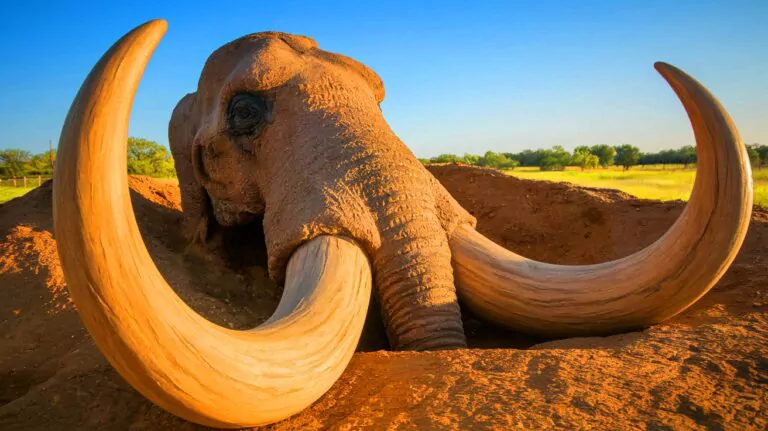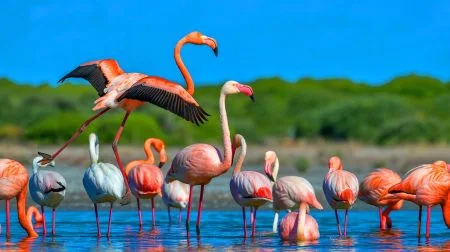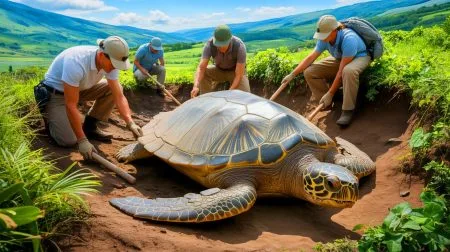| IN A NUTSHELL |
|
In the heart of Texas, a fascinating discovery unfolded on a seemingly ordinary day. What began as the sighting of an unusual wooden stump transformed into an incredible archaeological find. A hunter, intrigued by the oddity, presented a photograph to Will Juett, the director of a local ranch. This image sparked a series of events that led to a groundbreaking revelation: the “stump” was, in fact, a mammoth tusk. As researchers prepare for further analysis, this discovery sheds light on the region’s prehistoric past and inspires vivid imaginations.
An Unlikely Find: The Mammoth Tusk
Archaeological fossils, over time, can become so polished that they resemble organic materials like wood. This was precisely the case in west Texas, where a hunter stumbled upon what he thought was an unusual tree stump on a ranch. Intrigued by the peculiar appearance, the hunter captured a photo and shared it with the ranch’s director, Will Juett. Initially, Juett was skeptical, suspecting it was merely a piece of an old trunk.
Flu Season in the U.S. Reaches Its Most Intense Level in 15 Years
However, the situation took an unexpected turn with the arrival of researchers. After careful inspection, they confirmed the astonishing truth: the “stump” was a mammoth tusk. This discovery not only challenged initial perceptions but also opened a window into the ancient history of the land. Such instances highlight the transformative journey from skepticism to revelation, reminding us of the earth’s buried secrets waiting to be unearthed.
The Research Team’s Expedition
A trio of experts embarked on a mission to the ranch upon receiving the news. Led by director Bryon Schroeder, the team included archaeologist Erika Blecha and Haley Bjorklund, a graduate student from the University of Kansas. Bjorklund, a collaborator with the Center for Big Bend Studies (CBBS), specializes in environmental archaeology and has a keen interest in studying ancient animals like the mammoth.
The world’s mightiest ocean current crumbles as unprecedented Antarctic ice melt rewrites history
The tusk was found in a creek bed, and the team swiftly identified it as an isolated tusk, detached from other remains. As Bryon Schroeder noted, this discovery was significant in its own right. Over two days, the researchers meticulously encased the tusk in plaster, ensuring its safe transport to the Sul Ross State University (SRSU) Alpine campus. This careful process underscores the importance of preserving delicate historical artifacts for future study.
Mammoths and Their Human Contemporaries
The ultimate goal is to transport the tusk safely to the SRSU campus for an in-depth study, including carbon dating to precisely determine its age. Thanks to modern techniques, carbon dating can now narrow the age range to a precise 500 years. Such precision offers invaluable insights into the timeline of these magnificent creatures.
Breakthrough air-powered tech claims to recycle 94% of plastic in just 4 hours using moisture
Beyond its historical value, the tusk ignites the imagination of experts and enthusiasts alike. Will Juett expressed his wonder, imagining the massive mammoth roaming the O2 ranch hills. This vivid imagery connects us to the past, evoking a time when humans may have encountered these colossal beings with nothing but simple stone tools. It is a testament to the enduring fascination with the coexistence of mammoths and early humans.
The Impact of the Discovery
The discovery of the mammoth tusk has sparked excitement and curiosity among researchers and the local community. This find not only contributes to our understanding of prehistoric life in Texas but also serves as a reminder of the ever-changing landscape of archaeological research. Each new discovery adds a piece to the puzzle of our planet’s history, offering new perspectives and insights.
As the team continues their study, the significance of such discoveries becomes even more apparent. They provide a tangible connection to a world long gone, inviting us to explore and question the mysteries of our past. What other secrets might the land hold, waiting for curious minds to uncover?
The mammoth tusk discovery in Texas is a testament to the power of curiosity and the relentless pursuit of knowledge. From a simple photograph to a groundbreaking revelation, this journey highlights the importance of preserving our natural history. As we look to the future, what other hidden treasures might we uncover, and how will they reshape our understanding of the past?
Did you like it? 4.4/5 (27)








Wow, a mammoth tusk in Texas? That’s mind-blowing! 🤯
Google, mammoth lake in Clute texas.
This is so cool, but how does it “rewrite history” exactly?
Would love to see more photos of the tusk! 📸
Thanks for sharing this fascinating discovery! 👍
Why was the hunter looking for “unusual” stumps in the first place? 🤔
Does this mean mammoths were more common in Texas than we thought?
Imagine if someone used it as a coat rack! 😂
Carbon dating can narrow it down to 500 years? That’s impressive! 🧪
Is there any chance of finding more tusks or bones in the area?
How do they transport something so fragile without breaking it?
It’s amazing how something thought to be a stump turned out to be a tusk.
Can they extract DNA from the tusk to learn more about the mammoth?
Just shows you never know what might be buried in your backyard! 🤷♂️
Are there any other significant archaeological finds in Texas like this?
I bet the hunter feels like Indiana Jones now! 🏺
What kind of tools do researchers use to inspect such artifacts?
Hope the analysis reveals something truly groundbreaking! 🦣
Thank you to the researchers for preserving such an important piece of history.
How deep was the tusk buried in the creek bed?
Great article! Really makes history come alive. 😊
What happens to the tusk after the study is complete?
I have so many questions! How did it end up in Texas?
Can’t wait to hear more about the results of the carbon dating.
Could this discovery change our understanding of mammoth migration patterns?
Just another day in Texas, where even the stumps are prehistoric! 🌵
Would love to see a documentary about this expedition.
Is there any information about the hunter who found it?
Maybe next time, they’ll find a whole mammoth skeleton! 🦴
How long does the carbon dating process take?
Goes to show, one person’s stump is another person’s treasure! 🏆
What are the chances of finding more artifacts in that area?